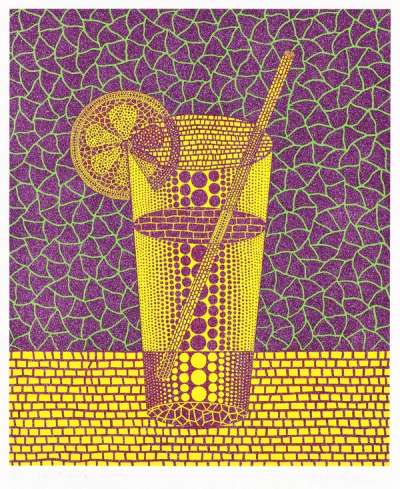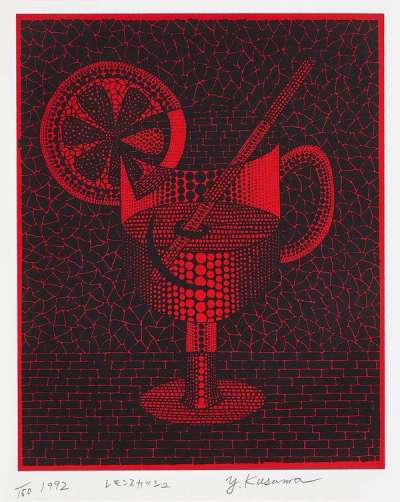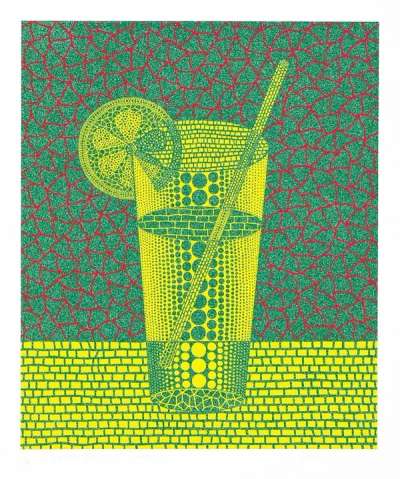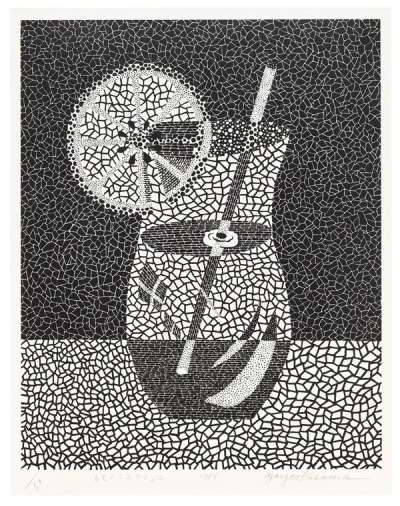Lemon
Squash
The following prints, created between 1984 and 2000, by Yayoi Kusama collect still-life representations of a tall glass of lemon squash, with the artist’s signature clashing fields of pattern, vibrant hues, and superimposed dots. The works are, as ever, celebratory: Kusama’s glass seems always to be more than half-full.
Yayoi Kusama Lemon Squash For sale
Lemon Squash Value (5 Years)
Works from the Lemon Squash series by Yayoi Kusama have a strong market value presence, with 50 auction appearances. Top performing works have achieved standout auction results, with peak hammer prices of £60000. Over the past 12 months, average values across the series have ranged from £10575 to £45008. The series shows an average annual growth rate of 13.11%.
Lemon Squash Market value
Auction Results
| Artwork | Auction Date | Auction House | Return to Seller | Hammer Price | Buyer Paid |
|---|---|---|---|---|---|
 Lemon Squash Yayoi Kusama Signed Print | 12 Jul 2025 | SBI Art Auction | £8,925 | £10,500 | £12,000 |
 Lemon Squash 5 Yayoi Kusama Signed Print | 25 Jun 2025 | K Auctions | £20,400 | £24,000 | £28,000 |
 Lemon Squash Yayoi Kusama Signed Print | 26 Apr 2025 | Mainichi Auction, Osaka | £13,600 | £16,000 | £19,000 |
 Lemon Squash 2 Yayoi Kusama Signed Print | 26 Jan 2025 | SBI Art Auction | £34,000 | £40,000 | £50,000 |
 Lemon Squash Yayoi Kusama Signed Print | 24 Aug 2022 | K Auctions | £18,700 | £22,000 | £25,000 |
 Lemon Squash 1 Yayoi Kusama Signed Print | 20 Jul 2021 | Christie's New York | £10,625 | £12,500 | £17,000 |
Sell Your Art
with Us
with Us
Join Our Network of Collectors. Buy, Sell and Track Demand
Meaning & Analysis
Yayoi Kusama's Lemon Squash, some screen-prints and others lithographs, created between 1984 and 2000, are still-life representations of a tall glass of lemon squash, with the artist’s signature clashing fields of pattern, vibrant hues, and superimposed dots.
Leaning into the art historical tradition of the still life, Yayoi Kusama subverts the traditionalism of the genre of as she moves away from the realism of the old master’s paintings and finds her own way to evoke depth and form. She uses her iconic dots motif to give roundness and simulate transparency in her glasses, concentrating larger dots towards the centre of the cylindrical shape and radiating smaller dots away from this point.
In this unique means of representation, her iconic dots are not merely decorative, but provide depth and dimensionality in an evolved version of half-tone. Half-tone was an early and inexpensive printing method, which gained popularity in the early days of digital printing. Thus Kusama’s dots in her Lemon Squash prints possess a strongly retro appearance that is both of the artist’s trademark style and referencing the style of advertisement artworks of the early to mid-20th Century period. The prints in this series possess notable joie de vivre, embodying Kusama’s rare stoic personality and celebrating the vibrancy of everyday objects. One thing stands out: Kusama’s glass seems always to be more than half-full.














